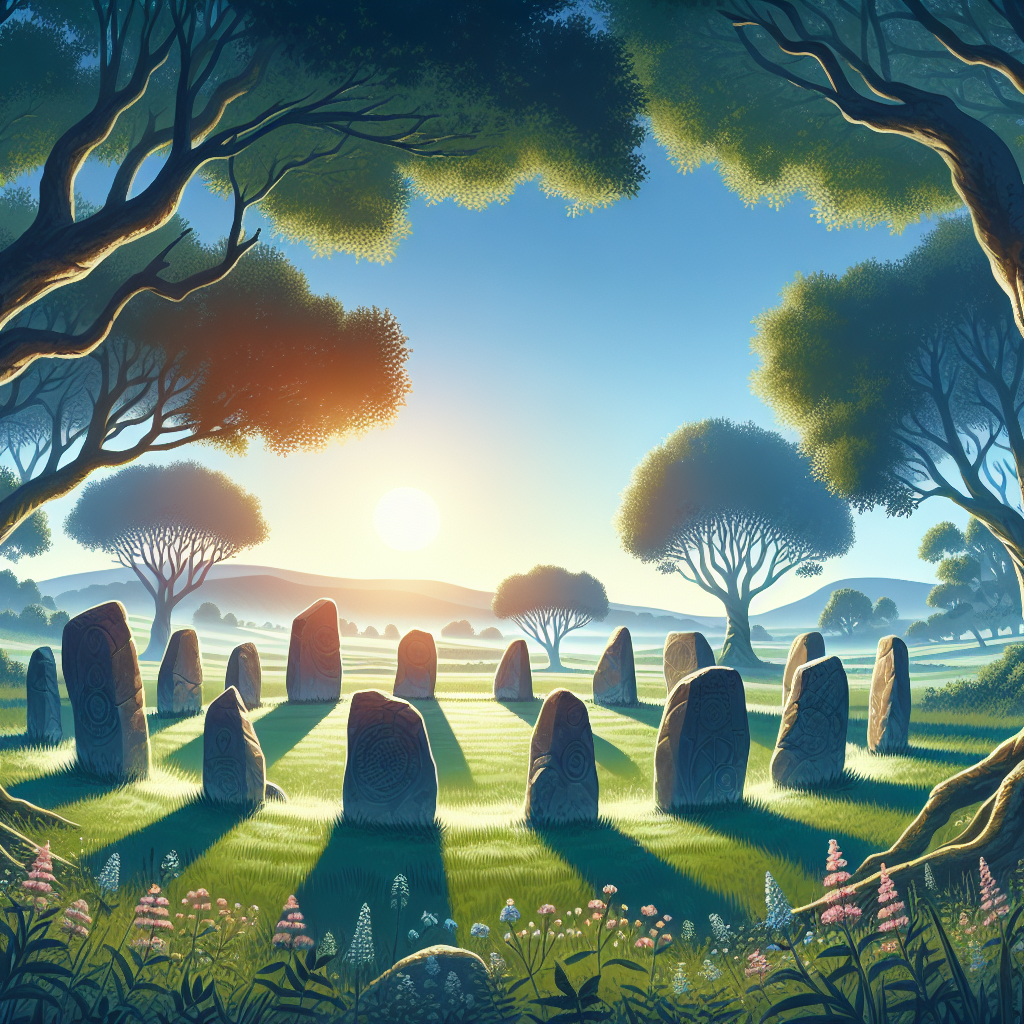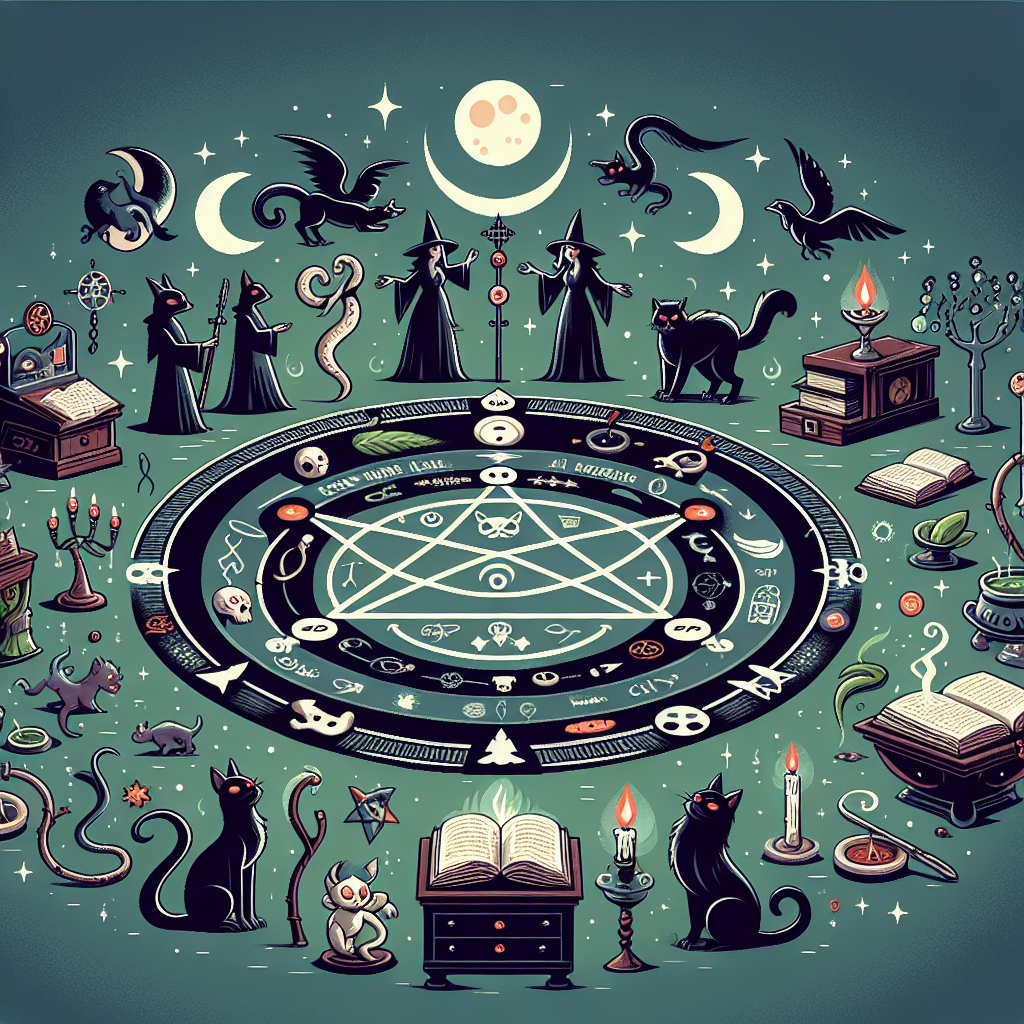As an Amazon Associate I earn from qualifying purchases.
Wicca, a modern Pagan religion that celebrates nature, emerged in the first half of the 20th century, but its roots can be traced back to ancient pre-Christian and pagan beliefs. Originating in England during the 1940s and 1950s through the activities and writings of Gerald Gardner, Wicca draws upon older witchcraft traditions, folklore, as well as ceremonial magic and the occult.
The practice of Wicca is underpinned by a reverence for the Earth and a belief in the divine as manifest in nature, which pre-dates Christianity and can be found in various ancient civilizations, including the Celts and Norse. Gardner, often referred to as the “Father of Wicca,” claimed to have been initiated into a coven of witches in the New Forest region of England and asserted that what he was revealing was a surviving great witch-cult, which had existed in secret for centuries. His influential books, such as “Witchcraft Today” (1954) and “The Meaning of Witchcraft” (1959), laid the foundation for Wicca as a religious movement.
While some critics have been skeptical of Gardner's narrative and question the unbroken lineage to ancient times, others acknowledge that Wicca is a syncretism of older pagan traditions, adapted to the sensibilities and issues of the modern world. Many of the rituals and spells utilized by Wiccans are inspired by older practices, although they have been modified over time. For instance, the Wheel of the Year, which outlines the cycle of seasonal festivals celebrated by Wiccans, incorporates both Celtic and Germanic pagan festivals.
An engaging element of Wicca is its flexibility and lack of centralized authority, which allows practitioners to adapt beliefs and rituals to their own preferences. Such customization has greatly contributed to Wicca's expansion and popularity, especially in the United States, where religious surveys estimate that there are approximately 1.5 million people practicing Wicca or some form of Paganism today.
This growth has been bolstered by the digital age, which facilitated the spread of Wiccan ideas through online communities and resources, making it easier than ever for individuals to learn about the religion and connect with other practitioners. This ease of access to information has also spurred diversity within the Wiccan community, leading to the rise of various traditions and solitary practices that coalesce under the broad umbrella of modern Witchcraft and Wicca.
“`html
Exploring the Origins of Wicca: Uncovering the Historical Roots of a Modern Pagan Practice
“`
Wicca, a modern Pagan religion that draws from a diverse tapestry of beliefs and practices, emerged in the mid-20th century through the influential work of Gerald Gardner and Doreen Valiente. Emphasizing reverence for nature, the practice of magic, and worship of a Goddess and God, Wicca traces its roots back to pre-Christian traditions and folklore, as well as more contemporary influences like ceremonial magic, Freemasonry, and Romantic literature. While it is often portrayed as ancient, Wicca is a distinctly new religious movement, shaped by a synthesis of older esoteric knowledge and modern occultist thought. This has led to a rich and evolving faith, which honors cyclical time and the Divine in its many forms. Our exploration will delve deeper into Wicca's eclectic heritage and its unique place in the tapestry of world religions.
Where Does Wicca Come From? Tracing Its Roots
The origins of Wicca are often shrouded in mystery and misinterpretation, but its roots can be traced back to early 20th century England. Wicca is a modern pagan, witchcraft religion that has gained widespread popularity across the globe. It was developed in the 1940s and 1950s by a British civil servant named Gerald Gardner.
Gardner, often referred to as the “Father of Wicca,” claimed to have been initiated into a coven of witches in the New Forest region of England in 1939. Here, he said he learned ancient practices that were the remnants of a pre-Christian, pagan religion of Britain and Europe. Gardner's exposure to various occult elements and the teachings from this coven formed the basis of what he would later organize and present as Wicca.
Following the 1951 repeal of the Witchcraft Act in England, which decriminalized witchcraft, Gardner published “Witchcraft Today” (1954), effectively documenting the beliefs and practices of this religion to the public for the first time. In his works, Gardner incorporated elements of the writings of Aleister Crowley, folklore, Freemasonry, and the ceremonial magic of the Hermetic Order of the Golden Dawn, blending these with what he professed to be remnants of the Old Religion.
Drawing upon these resources, Gardner created a structured system of magical practices, seasonal rituals known as Sabbats, and the worship of a Goddess and a God. The duotheistic theology embraced by Wiccans was revolutionary at the time, as it offered an accessible outlet for those seeking spirituality outside of the structure of conventional religions.
As Wic with a particular emphasis on direct personal experience, Wicca began to appeal to a growing number of people who desired a more intimate connection with nature, the Divine, and community. Gardner's Wicca was initiatory, meant to be practiced within a coven. However, as it spread, variations emerged, with some traditions, like those propagated by writers Doreen Valiente and Alex Sanders, developing their own unique practices.
One of the critical features of Wicca is its adaptability and inclusiveness. Since its inception, it has branched off into several traditions, each with its own specific beliefs, rituals, and practices. Some practitioners identify as solitary witches, practicing alone rather than in groups, and others combine Wiccan beliefs with elements of other spiritual paths in what is known as Eclectic Wicca.
The proliferation of Wicca and its public visibility grew exponentially during the latter half of the 20th century, particularly in the United States. This was helped along by a general surge of interest in alternative spirituality during the 1960s and 1970s, and the rise of feminist spirituality, which resonated with Wicca's emphasis on the divine feminine.
Wicca's reverence for the earth and nature aligns closely with environmental and ecological concerns, which has made it particularly appealing in an age of heightened awareness about environmental issues. The religion's ethical foundation, encapsulated by the Wiccan Rede “An it harm none, do what ye will,” promotes a principle of personal responsibility that is appealing to a broad spectrum of individuals seeking a progressive, ethics-based spiritual path.
As of the latest surveys, Wicca is experiencing continued growth, with estimates that there are hundreds of thousands of practitioners worldwide. The American Religious Identification Survey of 2008 found Wicca had experienced significant growth in the United States, with numbers of adherents exceeding 600,000. Considering Wicca's relatively recent emergence as an organized religion, this is a testament to its significant impact and enduring appeal in the realm of contemporary spirituality.
https://youtube.com/watch?v=RhfUqyxwJS0
1. What is Wicca and when did it originate?
Wicca is a modern Pagan religion that emerged in the first half of the 20th century, with its formal founding generally dated to the 1950s through the activities and writings of Gerald Gardner. It draws upon various older folk traditions and esoteric movements but is recognized as distinctly contemporary in practice.
2. Who is considered the founder of Wicca?
Gerald Gardner, a British civil servant and amateur anthropologist, is credited as the founder of Wicca. He was instrumental in bringing attention to the religion through his books and the establishment of covens.
3. Are there ancient roots to the practices in Wicca?
Yes, Wicca borrows from various mythologies, mystical traditions, and pre-Christian pagan rituals. However, it reconstructs and repurposes these elements in a way that is unique to the religion itself.
4. Is Wicca related to witchcraft?
Wicca is often associated with witchcraft as it incorporates the practice of magic and spellcasting within its rituals. However, not all witches identify as Wiccan, and Wicca as a religion encompasses more than just the practice of witchcraft.
5. What is the role of nature in Wicca?
Nature plays a central role in Wicca, with the religion emphasizing a deep connection to natural cycles, reverence for the Earth, and the use of natural elements within rituals and magic practices.
6. How do Wiccans view the divine?
Wiccans commonly believe in a dual divinity, worshiping both a Goddess and a God, who represent various aspects of life, nature, and the universe. Some traditions in Wicca may also recognize a more unified divine or multiple deities.
7. Can Wicca be considered a reconstruction of ancient pagan religions?
Wicca is not a strict reconstruction of ancient pagan religions but rather a new religious movement that is inspired by elements of pre-Christian beliefs and practices, synthesized with modern esoteric and theosophical influences.
8. Is there a sacred text in Wicca?
Wicca does not have a single sacred text akin to the Bible or the Quran. However, many Wiccans use a “Book of Shadows,” which is a personal or coven's collection of rituals, spells, and religious teachings.
9. Do all Wiccans practice in the same way?
No, Wiccan practices can vary widely between practitioners and covens. There are various traditions within Wicca, and individuals often personalize their practice to fit their own beliefs and experiences.
10. Are there organized churches or temples for Wiccans?
Wicca doesn't generally operate with centralized places of worship like churches or temples. Wiccans usually practice in private homes, outdoor spaces, or in rented halls that can accommodate group rituals, often organized within covens or as solitary practitioners.

Conclusion
Wicca traces its roots back to the early 20th century with significant contributions from figures like Gerald Gardner, who is often recognized as the father of modern Wicca. He wove together various threads of occult practices, folklore, and mythology to form a coherent religious path. Gardner's Wicca was heavily influenced by earlier esoteric traditions such as ceremonial magic, the Hermetic Order of the Golden Dawn, and the writings of Aleister Crowley. It also drew inspiration from pre-Christian pagan beliefs and seasonal cycles. The resulting Wiccan tradition highlighted the worship of a Goddess and a God, the practice of magic, and the celebration of eight Sabbats marking the changing seasons.
As Wicca evolved, it branched away from Gardner's specific tradition, giving rise to numerous traditions and solitary practices. Doreen Valiente and other prominent figures contributed significantly to the expansion and diversity of Wiccan beliefs and practices, making it a fluid and dynamic path. Contemporary Wicca continues to be an amalgamation, embracing ecological awareness, personal growth, and respect for diversity. The religion's adaptability and reverence for nature have attracted a growing number of practitioners worldwide, making it a notable part of the modern spiritual landscape. Wicca's enigmatic origins contribute to its mystery and appeal, allowing adherents to connect with the spirituality in a deeply personal way.
Amazon and the Amazon logo are trademarks of Amazon.com, Inc, or its affiliates.


